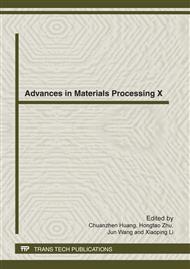p.550
p.556
p.563
p.569
p.574
p.580
p.586
p.591
p.596
Multi-Scale Fe Modeling Inconel718 Machining Process and Crack Initiation of Brittle Particle
Abstract:
nconel718 is particle reinforced metal matrix composites widely applied in important fields. To evaluate the impact of particles on the machined subsurface in Inconel718 during high-speed machining operation, a multi-scale orthogonal cutting finite element (FE) model is established. A cohesive element technique is adopted to predict particle crack initiation process. The multi-scale FE model is validated with experimental data in terms of cutting forces and chip morphology. The simulation reveals that particle has a great influence on surface roughness and the feed force when particles are located in the sub-surface within the depths of 30μm, and the cutting process has less effect on the particle crack initiation when the particles in the depths of more than 40μm or deeper. The interaction effects generated from particle sizes in the same depth are investigated on the cutting process and particle crack initiation.
Info:
Periodical:
Pages:
574-579
Citation:
Online since:
April 2012
Authors:
Price:
Сopyright:
© 2012 Trans Tech Publications Ltd. All Rights Reserved
Share:
Citation:


